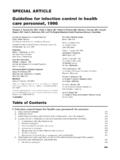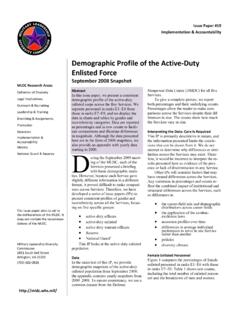Transcription of Students with Anxiety in the Schools - ed
1 49 GSCA Journal 2009 | Volume 16, No. 1 Students with Anxiety in the SchoolsStudents with Anxiety : The Role of the Professional School CounselorEvelyn H. Hanie and Rebecca Powell StanardEvelyn Hanie, is a school counselor at Whitewater Middle School in Fayette County, Georgia. For information regarding this article please contact Eve at: Stanard, is Professor and Interim Department Chair for the Counseling and Educational Psychology Department at the University of West article was completed as a partial requirement for an independent study for the degree at the University of West Georgia, under the direction of Dr. Rebecca P. Stanard (co-author). Eve will graduate from UWG in December is paper discusses how school counselors can support Students suff ering from Anxiety .
2 Th e causes and prevalence of Anxiety are presented as well as the diff erences between normal and problematic Anxiety . Th e role of school per-sonnel in early identifi cation is discussed with particular emphasis on the responsibilities of the school counselor. Th ese responsibilities include education of the staff , facili-tation of eff ective communication, and development of appropriate individual plans for these Students . Students with Anxiety in the Schools : The Role of the School CounselorPersonal experience is often like a bright light exposing the gap between reality and It s 1:39 and the telephone rings. I struggle awake wondering who could pos-sibly be calling at this time of night.
3 My daughter is a fi rst se-mester student at the university. Has something happened to her? I answer the phone. It is my daughter on the phone, but it s not her voice I hear. It s the sound of rapid shallow breath-ing followed by punctuated phrases of I can t breathe. I can t breathe. I struggle not to panic. I tell her to calm down and ask what s wrong. Th e rapid breathing is followed by phrases like I can t breathe. and I think I m going to die. My mind races and I try to stay calm. I m over an hour s drive from my daughter s dorm so all I can do is talk to her on the phone. Th e counselor in me kicks in and I work to help her slow down her breathing.
4 I talk to her in a soothing reassur-ing manner. After a long 20 minutes, she has calmed down. She tells me that she thinks she s okay now and she wants to try to sleep. I assure her that she can call back at any time if she wants to, tell her how much I love her, and hang up the phone wondering what in the world just happened. I later discover that my daughter and I had just experienced her fi rst full-blown panic have been a professional school counselor (PSC) for almost 20 years and I am familiar with many emo-tional and behavioral problems exhibited by Students in the Schools . My counselor education program em-phasized the recognition of symptoms of serious mental and emotional disorders as well as protocol for referral to appropriate mental health professionals (MHPs).
5 I had a working knowledge of Anxiety , particularly school anxi-ety, and how to work with Students with Anxiety ; how-ever, the increase in the number of Students experiencing problematic Anxiety made me realize how much more I needed to know. Traditionally, the responsibility of di-agnosis and treatment rested with the MHPs leaving the PSC in the position of support person. While this may be an important role, my limited knowledge of problematic Anxiety left me dependent on my basic counseling skills and intuition, parental input, and the treatment recom-mendations of others. I realized that I must become more knowledgeable about Anxiety to better support these stu-dents.
6 PSCs must be able to recognize the symptoms of Anxiety and communicate eff ectively in order to pro-vide appropriate recommendations and referrals. Th is is particularly important because many Students may not be diagnosed with Anxiety and, therefore, may not be Georgia School Counselors Association50 Students with Anxiety in the Schoolsreceiving treatment. PSCs may be the fi rst person with an understanding of problematic Anxiety these Students encounter. Th erefore, PSCs must understand how to sup-port and advocate for the Students which often includes the involvement of parents, school staff , and referral re-sources outside the school environment.
7 It is important to recognize that an Anxiety disorder diagnosis is not nec-essary for early intervention and support. Although there are many Anxiety disorder diagnoses, treatment plans for these disorders are typically based on symptoms and behaviors exhibited rather than on a particular diagnosis (Wagner, 2005). Th erefore, early detection and appropriate preventive interventions are extremely important. Within the context of this article, specifi c Anxiety disorders will be briefl y discussed; but the primary focus of this article is on the recognition and treatment of the behaviors and symptoms associated with problematic Anxiety .
8 Th e purpose for writing this article is to increase awareness of the PSC s role in the recognition, support, and potential diagnosis of Anxiety problems. Recognizing AnxietyManifestation of AnxietyAnxiety is defi ned as a subjective sense of fear, distress, or worry that may exhibit both physical sensations ( , headaches or nausea) and emotional symptoms ( , fear or nervousness) (American Psychiatric Association [APA], 2000). Anxiety disorders range from those associated with a specifi c thing or event (phobias) to those in which anxi-ety is evoked by a broad spectrum of situations, termed Generalized Anxiety Disorder. Due to frequent undiag-nosed Anxiety in young people, it is important for school counselors to have a basic knowledge of Anxiety and the ability to recognize symptoms.
9 Anxiety is a prevalent problem among young people. Although identifi cation and treatment of Anxiety disor-ders often do not occur until early adulthood, approxi-mately half of those treated for Anxiety indicate an earlier onset during childhood or adolescence (APA, 2000). Ac-cording to the Discovery Education (2005) report, anxi-ety disorders aff ect between 2% and 4% of the popula-tion and are the most common type of mental disorder in the United States. Erk (2004) estimates the prevalence of Anxiety disorders among children from 5% to 18%. Another study by Emslie (2008) reports similar numbers in the range of 6% to 20% of children and adolescents.
10 Anxiety is not just a problem for adults; it is a problem for young people, often manifesting itself in the school to Wagner (2005), about half of Students di-agnosed with an Anxiety disorder experience signifi cant diffi culty functioning at school. Anxiety lowers academic performance and productivity, although Students with mild levels of Anxiety can sometimes compensate using persistence and hard work. Tardiness, absenteeism, and perfectionism, common with more severe levels of anxi-ety, can lead to incomplete work, test failure, or possi-ble repetition of a grade. Dropout rates are high among Students with problematic Anxiety , but these fi gures are sometimes attributed to substance abuse and truancy which can mask untreated Anxiety .
















